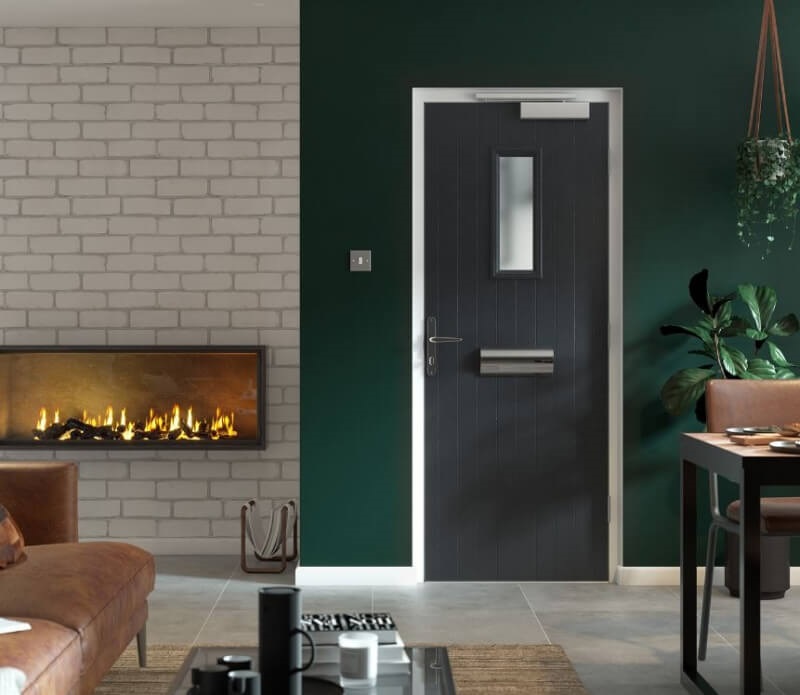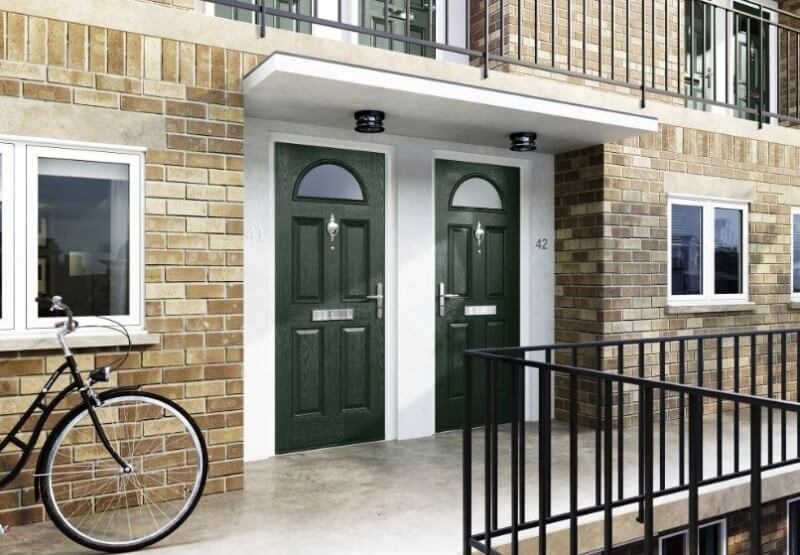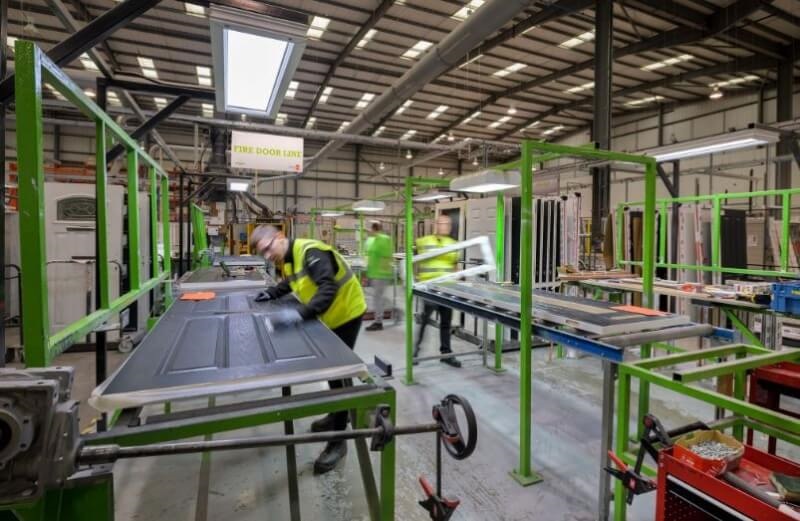
Fire doors are specially designed doors that play a vital role in protecting people and property, yet many of us don’t fully understand how they work or why they’re so important.
We’ve written this piece to explain what fire doors are, and whether you should add them to your home or business.
What is a Fire Door?
A fire door is a door designed to resist fire and smoke for a specific length of time. Fire doors are made from fire-resistant materials. They’re thicker than standard doors and include intumescent seals around the edge of the door that expand when exposed to heat, creating a barrier against smoke and flames.
The purpose of a fire door is to compartmentalise a building, containing fire and smoke to a specific area to:
- Protect escape routes so people can safely exit the building
- Slow the spread of fire and smoke damage
- Provide time for emergency services to respond
- Preserve as much of the building as possible
- Most importantly, save lives
When is a Fire Door Required?
Fire doors are a legal requirement in many situations, and their use is governed by building regulations and fire safety legislation. The need for fire doors can be determined by a fire risk assessment, which should be carried out by a competent person.
Commercial Premises
In commercial premises, fire doors are typically required in:
- Corridors and hallways that form escape routes
- Stairwells (especially in tall buildings)
- Between sections of a building used for different purposes, like separating a shop from office space or a warehouse
- Areas with high fire risks, like kitchens and electrical areas
Domestic Situations
In homes, fire doors may be required in:
- New build houses that are three or more storeys high (including loft conversions)
- Communal areas in blocks of flats
- Houses converted into flats
- Between a house and an attached garage
- In houses of multiple occupation (HMOs)
How Do Fire Doors Work?
Fire doors work as part of a passive fire protection system. Unlike active measures like sprinklers or fire extinguishers, passive fire protection is built into the structure of the building itself.
A properly installed fire door will have:
- A fire-rated door leaf (the door itself)
- A compatible fire-rated door frame
- Intumescent seals around the edges and top of the door
- Sometimes, smoke seals at the bottom of the door
- Self-closing mechanisms to ensure the door closes properly after use
- Fire-rated hinges and appropriate door hardware
When a fire breaks out, the heat causes the intumescent seals to expand, filling the gap between the door and the frame. This creates a barrier that helps contain the fire and stop smoke from spreading to other parts of the building.
Fire doors are rated according to how long they can resist fire – typically 30, 60 or 90 minutes. This rating indicates the minimum time the door should hold back fire and smoke.

Maintenance and Legal Responsibilities
Fire doors are only effective if they’re properly maintained. A damaged or improperly functioning fire door can fail to perform in the event of a fire.
Under current fire safety legislation, the ‘responsible person’ for the building (usually the owner, manager, or landlord) must ensure that:
- Fire doors are regularly inspected by a competent person
- Any issues are promptly addressed
- Fire door certification is kept up to date
- Occupants of the building understand the importance of not propping open fire doors or tampering with them

The Role of Fire Doors in Saving Lives
It’s difficult to overstate the important role fire doors play in saving lives. In a burning building, every second counts. Modern fire doors are designed to hold back fire and smoke, giving people precious time to escape and emergency services time to respond.
With properly installed and maintained fire doors, a fire can be contained in one area, allowing people to use protected corridors and stairwells to exit the building safely.
Fire doors also help protect the remainder of the building from extensive damage. By compartmentalising the fire, they can significantly reduce the overall impact on the structure and contents.
Our Fire Door Solutions
At Double Glazing Essex, we understand the critical importance of fire safety. We install high-quality Masonite Fire Doors that fully comply with the latest fire certification requirements. These doors combine a solid timber core with a GRP (Glass Reinforced Plastic) outer layer to provide outstanding fire resistance without compromising on style or security.
Our Masonite fire doors offer:
- Complete compliance with current building regulations
- Effective protection against the spread of fire and smoke
- Robust security features including multi-point locking
- Intumescent seals that expand when exposed to heat
- Discreet door closers that can be adjusted to various opening forces
- Thermal efficiency for improved comfort and lower energy costs
- Attractive designs that complement your home or business
Each fire door we install comes with all the necessary certifications and fire door signage. Our experienced installation team ensures that every door is fitted to the highest standards.
Choosing the Right Fire Door
When selecting a fire door for your property, there are several important considerations:
Fire Rating
Masonite fire doors provide reliable fire protection, with ratings that match the requirements for different building applications. The appropriate rating will depend on the building and needs.
Door Design
Our Masonite fire doors are available in ten stylish models, ranging from traditional to contemporary designs. Unlike fire doors of the past, modern fire doors can be both safe and visually appealing.
Glazing Options
We offer fire doors with various glazing options, including single and double box glass sections and half-moon glazed areas. All glazed sections use patented fire glass that maintains the door’s integrity during a fire while still allowing light to pass through.
Hardware
All our fire doors come with fire-rated hardware, including grade 13 stainless steel hinges and letterplates. These components are specifically designed to withstand fire conditions and ensure the door functions correctly. You can choose from a selection of stylish handles, knockers, and other accessories to complete your door’s appearance.
Protecting What Matters Most
Fire doors are a crucial part of any building’s fire safety precautions. They play an essential role in containing fire and smoke, protecting escape routes, and giving people time to exit safely in the event of fire. Understanding the purpose and importance of fire doors helps ensure they’re used correctly and maintained properly.
If you’re considering installing or replacing fire doors in your property, we’re here to help. Our team at Double Glazing Essex can provide expert advice on the right fire doors for your needs and ensure they’re installed to meet all relevant standards.
For more information about our fire door solutions, you can call us on 01268 424 904, email us at sales@doubleglazingessex.com or use our online contact form.
If you’d like to meet us in person, then we’d love to host you at our showroom. You can find this at 101 London Road, South Benfleet, SS7 5TG.
Frequently Asked Questions
How can I tell if a door is a fire door?
A fire door should have a certification label or plug on the top edge of the door, showing its fire rating. It will also be considerably heavier than a standard door, have intumescent seals around the edges, and appropriate signage.
Can I paint or modify a fire door?
No. Fire doors are carefully engineered safety products that should never be modified. Painting, cutting, or altering a fire door in any way can compromise its fire-resistant properties and may render its certification invalid.
How often should fire doors be inspected?
In commercial buildings, fire doors should be inspected at least every six months. In higher-risk buildings or those with high traffic, more frequent inspections may be needed. In domestic settings, regular checks for damage or improper functioning are recommended.










